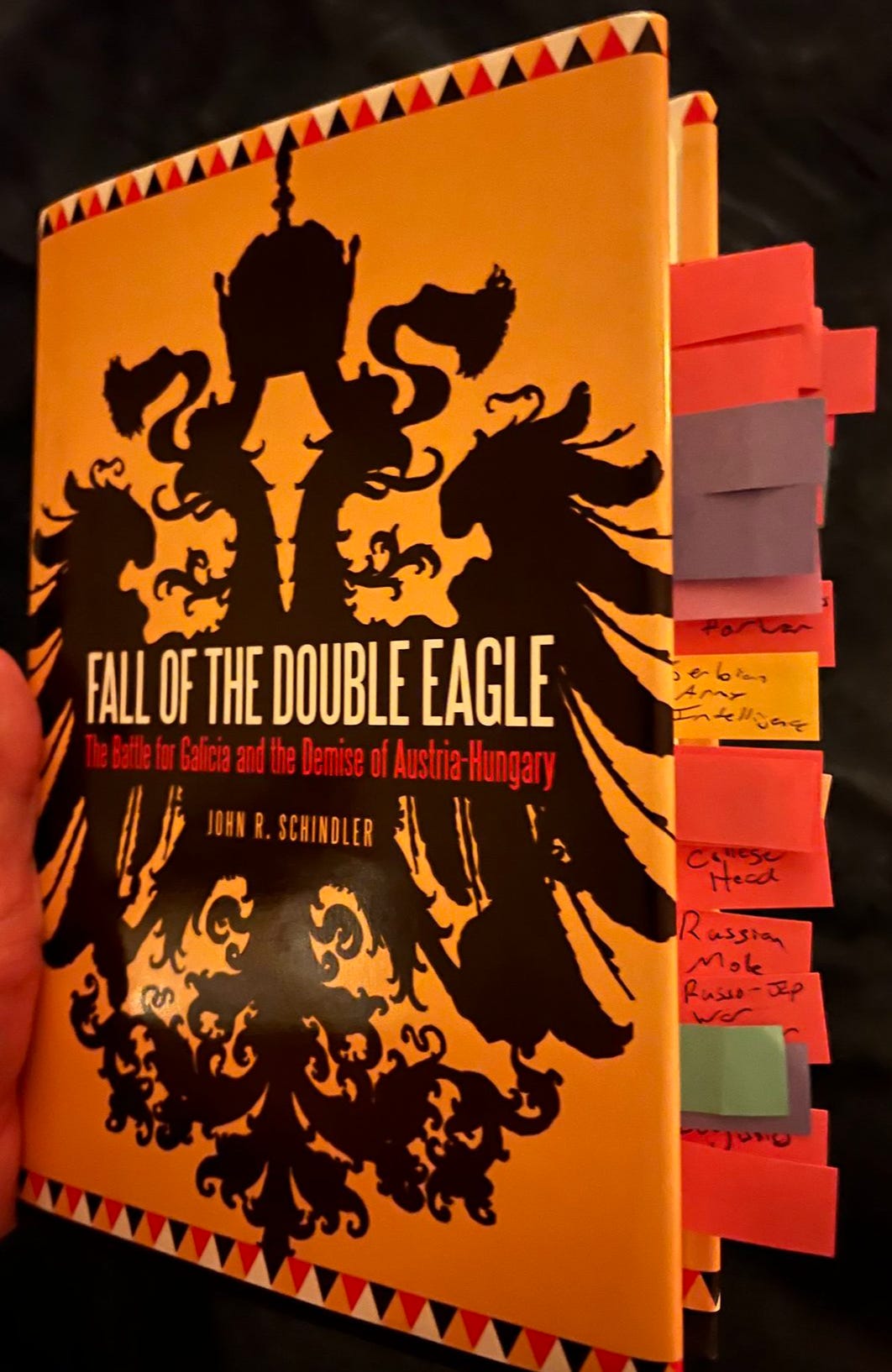I am a fairly organized person in most ways, particularly in my work life. Since I try to treat writing as work, my organization extends into preparing for writing projects.
Alternate history is a genre with pretty high expectations for historical accuracy, something that amuses me greatly considering it’s speculative fiction. But that fiction has to be built upon something: hopefully a basis of fact from which the reader can start developing an understanding of the universe.
That means is that there are a lot of facts and information to keep track of, something that can get overwhelming quickly. From large-scale things like timeline, major events, important factions, etc. to little things like how people dressed, character ages, and a host of other details. There is a lot, and I thought someone might benefit if I shared how I collect and organize information.
If I start with a physical book, I end up with the image above. I read this book as research for my Austro-Hungarian Alternate History, which you can read about here:
Make Austria-Hungary Strong
I’ve written before of my love for real-life and alternate history. A lot of my Reading Recaps have been notes on history-related books. And obviously I love writing alternate history as you may have noticed.
I got these little colored sticky notes that you can write on and put wherever you want. The different colors usually represent different information: red or pink for military-related information, purple for government/diplomacy/country information, and yellow/gold for important people.
All of these will get translated into a Microsoft OneNote document. OneNote is indeed a Microsoft product, so if you don’t have a Microsoft 365 subscription you probably won’t have access to it. But if you do have a subscription, OneNote is a fantastic tool for organizing information.
I’m a Mac user, so this might look a little different if you’re using Windows. One of the big benefits of OneNote is the flexibility in how you structure the information. You start with an upper-level ‘Notebook’, which I named ‘Austria-Hungary and you can see in the top left of the screenshot below.
I just have a single section right now, called ‘Research,’ with a bunch of subfolders. You can make as many of these as you want, I have eight at the moment. As you can see, the screenshot is of the ‘Notable People’ page and I’ve inserted a bunch of tables into this page to hold details on all these people.
Not all of these will appear in the story, but they are all important or interesting for one reason or another. If you look at the picture of the book earlier there is a yellow tag in the middle of the book with ‘Serbian Military Intelligence’ written on it. That tag is for a man named Dragutin Dimitrijevic, a Colonel in Serbian Army Intelligence at the outset of World War 1. He’s important for a number of reasons, primarily because he was a senior member of the Black Hand, a secret military society that overthrew the Serbian monarchy and who likely planned and organized the assassination of Archduke Franz Ferdinand, sparking World War 1. Considering that my main character for the story is Franz Ferdinand… I figured it was important to keep track of people who might have it in for him.
I’ve made different tables for different nationalities. You can insert them wherever you want, move them around, add hyperlinks, etc. Under the ‘Germany’ section you can see several names underlined and in blue that are hyperlinks to research material about that person.
One of the helpful things you can do in OneNote is to create internal links. You highlight any piece of text or an image, right click on that text and you get an option to ‘Copy Link to Paragraph’ to generate a hyperlink. Wherever you want to put that link, just highlight a piece of text or image, right click, and click ‘Insert Link.’ You can now cross-reference throughout the Notebook however you want.
In addition to tables, you can free draw inside any document which would be fantastic if you’re working with a tablet or laptop that works with a pen. I tend to draw maps for battles so I can keep things straight, and being able to do that directly in my research document will be really useful.
That’s how I keep things organized and it’s been pretty helpful to me. How do you guys keep track of information? What’s the best way you’ve found to do that? Let me know in the comments. Thanks for reading and I’ll see you next time!








As I've mentioned *ad nauseum*, I use Scrivener for this. I load up my Research part of the Binder with pdf files and some web page links. I'm cutting back on the links because the app keeps the connection going even when not being accessed, which can slow down the response when you're typing on the app. 🤦♂️ I put tons of files for dialect, weapons, clothing, organizations, etc., in the Scrivener file (it's actually a folder). Once I back it up, I then do an airdrop to my iPad and back after the 1st Draft is finished. It works for me, but I've invested the time and effort researching how to use the Scrivener app.
This looks to be a great guide. I'm working a steampunk/fantasy set in a different North America in the 1870s and was wondering how to organize things.